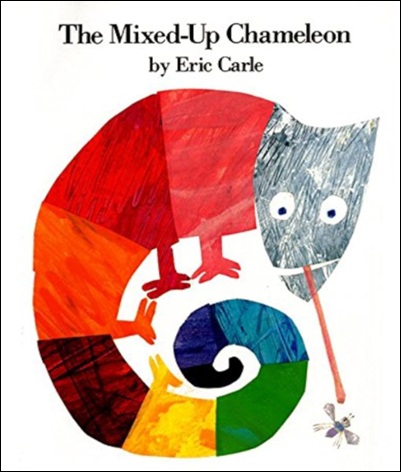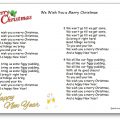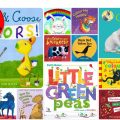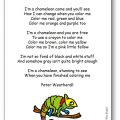Author: Eric Carle
Illustrator: Eric Carle
Publisher: HarperCollins Publishers
Year: 1975
Language: English
Type of resource: Illustrated picture book with repetitive structure
Themes: Animals, zoo, identity, self-acceptance, wishes, humour
Age range: 4 to 8 years old
School levels: Pre-K to Grade 5
Main learning objective: Introduce animal vocabulary and work on listening comprehension and expressing wishes
Main language objective: I can name animals and express a wish using “I wish I could…”
Summary of the Book
On a green leaf, a small chameleon lives a quiet life, changing colour with his surroundings and catching flies. One day, he sees a zoo full of fascinating animals. Feeling small and unremarkable, he starts wishing to be like each of them: strong like an elephant, beautiful like a flamingo, clever like a fox, fast like a deer… His wishes come true and his body transforms into a mix of all these animals. But soon, he realises he can no longer move or catch flies. When a fly passes by, he wishes to be himself again, regaining his identity and purpose. A poetic story about self-acceptance.
Culture and Vocabulary
The book offers a cultural insight into iconic zoo animals, which are often featured in English-speaking children’s literature. It provides an opportunity to explore the themes of identity, self-esteem, and the value of diversity. The chameleon, an exotic animal that young children may not be familiar with, sparks curiosity and serves as an excellent prompt to reflect on how we build our sense of self in relation to others.
- Animals: chameleon, polar bear, flamingo, fox, fish, deer, giraffe, turtle, elephant, seal, fly
- Colours: green, brown, red, yellow, gray, white, sparkling
- Adjectives: small, big, slow, weak, strong, smart, funny, handsome, dull, sparkling
- Action verbs: wish, turn, move, rest, swim, run, hide, catch, see, be, sit, wait
- Idiomatic expressions: “I wish I could…”, “Just then”, “a little of this and a little of that”, “That was its life”
Grammar and Structures
- Wishes with “I wish I could…”: “I wish I could be strong like an elephant.”
- Descriptive adjectives: “big and white like a polar bear”, “sparkling green, “gray and dull”
- Simple past tense: “The chameleon moved…”, “It turned…”, “The chameleon saw a zoo.”
- Simple present tense: “It moves onto a brown tree.”
- Indirect questions and exclamations: “How small I am!”
- Coordination with “and”: “a little of this and a little of that”
- Comparatives with “like”: “like a polar bear”, “like a fish”
Phonology
- Contrasting sounds: bear / deer, fox / fish, giraffe / chameleon
- Vowel contrasts: fish / wish, deer / bear, fox / box
- [s] and [z] sounds: “eyes”, “nose”, “flies”, “chameleon’s”
- Alliterations: “slow and small”, “long, sticky tongue”, “sparkling green”
- Intonation of exclamatory sentences: “But was it happy? No!”, “How slow!”
- Rhythmic repetition and chant-like structure: “I wish I could…”
Teaching Suggestions
Before Reading
- Observe the cover and predict what kind of animal it is
- Introduce zoo animal vocabulary using flashcards or figurines
During Reading
- Repeat the phrase “I wish I could…” with gestures
- Point to body parts as they change and match them to the correct animals
After Reading
- Sequence the chameleon’s transformations
- Match each animal to its quality (e.g., fox = smart, elephant = strong)
Grammar Mini-Lesson
- Practice “I wish I could…” using animal cards and action verbs
- Identify comparative phrases with “like a…” and build new ones collaboratively
Differentiation
For younger learners: Focus on animal names with gestures and sounds. For advanced learners: Create their own wishes with animals or even objects (e.g., “I wish I could fly like a plane”).
Cross-Curricular Connections
Music: Song “Walking in the Jungle” (Super Simple Songs)
Art: Create a chameleon from drawings or animal collage
Social Studies: Discuss self-esteem and diversity using the theme “Be yourself”
Media Education: Make a short animal fact sheet with images
PE: Mime game with the animals from the book
Project Ideas
Animal Mix Workshop: Create your own ‘mixed-up animal
Objective: Imagine a new creature by combining features from different animals and assigning it special qualities. Each child presents their creation: It has wings like a bird and legs like a horse. This project can lead to a class exhibition or an illustrated collective book.
Further Reading: Giraffes Can’t Dance by Giles Andreae to extend the theme of self-acceptance. Dear Zoo by Rod Campbell to reinforce animal vocabulary and descriptive adjectives.
Conclusion
The Mixed-Up Chameleon is a must-have for primary school English teaching. It offers accessible and reusable vocabulary (animals, colours, qualities), simple and repetitive structures, and a meaningful message about self-identity. It encourages oral production, physical games, and creative expression in the classroom.





